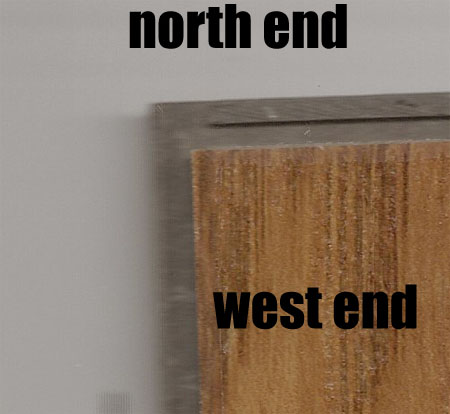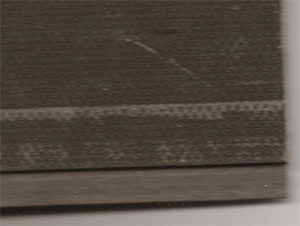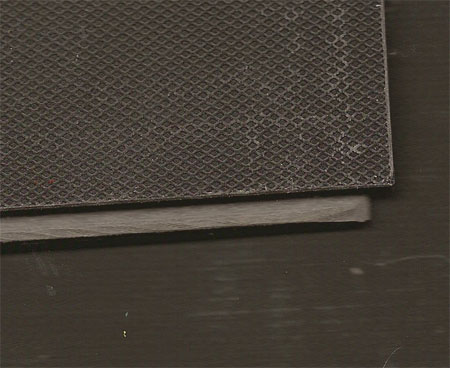|
|
|
machining precise grooves in tiles
Wednesday, January 25 2017
This morning I finally resumed the work of laying tiles in Gretchen's basement library. Eres, the guy she'd hired to do the painting and drywall repair, had finished his work while we were in Washington, and we'd picked up the necessary additional tile yesterday. I'd quickly learned that I couldn't just append tiles to the jagged edge I'd left in the middle of the floor because the way the tiles lock together prevented them new tiles being added to any void that was surrounded on three sides by existing tile. This meant that I would have to rip out most of the tile I'd installed in the library a year and a half before. A benefit of this would mean that I could remove the tiles with ugly scuff marks and us them in the closet under the stairs or cut them up to go along walls. This morning I added most of the new tile on the secondary door to the library, the one closest to the boiler room (the library has two doors, reflecting the fact that it was once two separate bedrooms; we'd torn the wall down between them the night we closed on the house back in 2002).
Later in the day, after filling in all the flooring in the under-stairs closet and a narrow panhandle to the secondary door, I ran my first course of tile connecting with existing flooring at the primary door. Though the ranks of tiles in the hallway dictating the position of tiles flowing in through the secondary door had diverged from those at the primary door by something like 20 feet, when they joined together in the library (having completely surrounded the stairs), they did so perfectly. That's how precisely these kind of tiles lock together.
In my remote workplace, while waiting for a big mailing to test my new postfix instance allocating code, I've been adding yet more features to the reporting system. Today I did most of the work necessary to permit a report user to keep adding dropdowns and picking items from each one, all to ultimately end up in a SQL IN clause. HTML permits multiple items to be selected in a dropdown, though I find this clunkier than just having multiple identical dropdowns.
This evening evening after work, I made a lot of progress on the library flooring project. But along the way I ran into yet another issue resulting from having only installed half the floor (and ending it in a jagged edge that had been hidden beneath a carpet). The tiles have definite edges that are different north and south and east and west such that the north ends lock perfectly with the south ends and the east ends lock perfectly with the west ends. This forces you to keep the tiles in their ranks and always orient them the same way for the entire flooring project (in this case, about 80% of the basement). And when you get to a wall and cut the tile, you can then use the resulting piece to begin the next rank at the other end of the room. The problem with all the jagged ranks that had never made it to a wall was that I didn't have any spare scraps with south ends to finish the ranks at the north end of the room. To finish the ranks correctly would've required me to cut a piece out of a brand new tile, leaving a scrap that I wouldn't be able to use (since that scrap would only have a north end, which is only good for completing ranks at the south end of the room, a place where all the ranks were complete). This wouldn't be a problem further east in the room, since I'd thought ahead and terminated the ranks with pieces perfectly sized for completing the rank should it ever reach the north end of the room. But the ranks on the west side of the room had been complicated by a closet, and I'd also found a use for the scraps with south ends at the north end of the hallway. What to do? to complete some of the ranks would've required only six inches of tile, meaning 40 inches would've been wasted. And I didn't think I'd bought enough tile to be that kind of wasteful.
Back in the summer of 2015, I'd had a few places where I'd needed very small pieces of tile tucked away mostly beneath baseboard, and in those places I'd violated the tile-locking paradigm in a few places by butt-joining tiles without any compatibility of locking details. I'd just cut them off and butt them against each other such that they were held in place by the other tiles around them. This had worked okay for little strips an inch or two in width. But I didn't feel like this would work for a full-width tile at the end of the rank, particularly if it was out in the floor six or twelve inches. I'd entertained the crazy notion of perhaps machining compatible grooves into the cut-end of a tile, but I'd never had machines capable of the necessary precision. (I do have a routing table, but the bits are all too wide.) Tonight, though, it occurred to me that I could probably use the table saw Gretchen's father had given me this summer for this task. Using a piece of tile with the arrangement of grooves I was hoping to imitate, I could set the depth of the blade and the position of the fence such that I could replicate it in the cut end of any tile. My first attempt was a bit clumsy, and it was hard to cut the groove to precisely the right depth (tolerances with these tiles are small fractions of a millimeter). And then it was hard to shave down the resulting ridge along the edge of the tile so that it locked correctly. But after some back and forth, I managed to machine a south end into a scrap. It was a joyous moment when it caught its neighbor almost perfectly. I ended up having to machine five south ends tonight, and by the end there I was doing it in five minutes or less. I was so proud of myself that I had to show Gretchen, and she was suitably impressed.

A piece of tile showing a north end and a west end. Otherwise we're looking at the part of the tile facing the room (with faux wood).

A piece of tile showing an east end. Otherwise we're looking at the ugly part of the tile that is against the floor.

A piece of tile showing a south end. It's hard to see, but there's a ridge along the machined edge of this tile. This was the kind of end I needed to machine (I don't have an example of my work; sorry!). Otherwise you're looking
at the ugly part of the tile that is against the floor.
For linking purposes this article's URL is:
http://asecular.com/blog.php?170125 feedback
previous | next |


